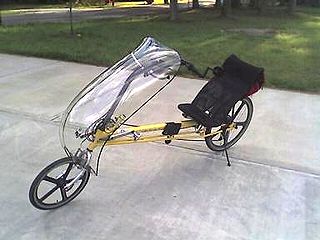
A bicycle, also called a pedal cycle, bike, push-bike or cycle, is a human-powered or motor-assisted, pedal-driven, single-track vehicle, with two wheels attached to a frame, one behind the other. A bicycle rider is called a cyclist, or bicyclist.

Jan Bos is a Dutch former speedskater and sprint cyclist. In the late 1990s he was world champion in speed skating and he competed in the 1998, 2002, 2006 and 2010 Winter Olympics.

Human-powered transport is the transport of person(s) and/or goods (freight) using human muscle power. Unlike animal-powered transport, human-powered transport has existed since time immemorial in the form of walking, running and swimming, as well as small vehicles such as litters, rickshaws, wheelchairs and wheelbarrows. Modern technology has allowed mechanical advantage devices and machines to enhance human-power.

A recumbent bicycle is a bicycle that places the rider in a laid-back reclining position. Recumbents are available in a wide range of configurations, including: long to short wheelbase; large, small, or a mix of wheel sizes; overseat, underseat, or no-hands steering; and rear wheel or front wheel drive. A variant with three wheels is a recumbent tricycle.

A tricycle, sometimes abbreviated to trike, is a human-powered three-wheeled vehicle.
Sam Whittingham is a Canadian cyclist who has held several world records on recumbent bicycles.

A velomobile ; velomobiel, velo, or bicycle car is a human-powered vehicle (HPV) enclosed for aerodynamic advantage and/or protection from weather and collisions. Velomobiles are similar to recumbent bicycles, pedal go-karts and tricycles, but with a full fairing and are not to be confused with purpose-built mobiles for speed records. Fully faired vehicles with two wheels, generally called Streamliners. Streamliners have set many speed and distance records.

The Race Across America, or RAAM, is an ultra-distance road cycling race held across the United States that started in 1982 as the Great American Bike Race.

A racing bicycle, also known as a road bike, is a bicycle designed for competitive road cycling, a sport governed by and according to the rules of the Union Cycliste Internationale (UCI).

Mike Burrows was an English bicycle designer from Norwich, England.

Bicycle performance is measurable performance such as energy efficiency that affect how effective a bicycle is. Bicycles are extraordinarily efficient machines; in terms of the amount of energy a person must expend to travel a given distance, cycling is calculated to be the most efficient self-powered means of transportation.

A handcycle is a type of human-powered land vehicle powered by the arms rather than the legs, as on a bicycle. Most handcycles are tricycle in form, with two coasting rear wheels and one steerable powered front wheel. Despite usually having three wheels, they are also known as handbikes.

A prone bicycle is a bicycle which places the rider in a prone position. The bottom bracket is located at the bicycle's rear; the rider lies either on a pad or in a hard-shell seat. The prone position of the rider's body can reduce aerodynamic drag and therefore increase the efficiency of the vehicle. It can also be more comfortable or ergonomic than other bicycles.

Greg Kolodziejzyk is a Canadian cyclist who has held several world records on recumbent bicycles and pedal-powered boats.
The World Human Powered Vehicle Association is dedicated to promoting the design and development of human-powered vehicles. Its main focus is coordinating between national HPV clubs with regard to competitions and records. The WHPVA also supports the Human Power eJournal, with a broader focus including stationary uses of human power.
Team Strawberry was a professional bicycle racing team that participated in experiments on human power/performance conducted by their primary sponsor, Balboa Instruments of Newport Beach, California. The Team was founded in 1988 by team captain Alan R. McDonald. It lasted 2 years for the purpose of testing Bicycle aerodynamics and power, human power measurement/logging, and competing in the 1989 HPV Race Across America. McDonald acquired New Zealand rider John Harvey, also an Ultra Marathon cyclist. They were later joined by Greg Ewing and Mike Haluza. During the 1989 RAAM, the team used the hi-tech prototype cyclocomputer called the "Power Pacer" designed by Balboa Instruments. The device measured each rider's individual performance in terms of power output and calories burned through an output device built into the rear wheel hub.

TerraCycle, Inc. is a designer and manufacturer of recumbent bicycle parts based in Portland, Oregon in the United States. TerraCycle is known for its idlers and Cargo Monster load-carrying extensions.
Jonkheer Sebastiaan Bowier is a Dutch cyclist.
The hour record is the record for the longest distance cycled in one hour on a bicycle from a stationary start. Cyclists attempt this record alone on the track without other competitors present. It is considered perhaps the most prestigious record in all of cycling. Over history, various cyclists ranging from unknown amateurs to well-known professionals have held the record, adding to its prestige and allure. There are several records, one of which is the record for streamlined human powered vehicles, also known as recumbent bicycles.













